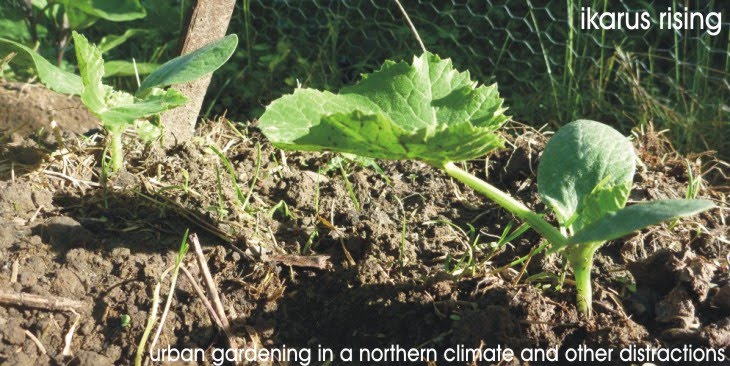We've now had two consecutive sunny days here and it's been fantastic. I don't know how much of the natural light is actually hitting the plants with the lighting fixtures in the way, but it's still nice to see the greenhouse lit up by the window. The sunlight also helps heat the sunporch, which is always appreciated.
I've been trying to plan out the next stage for the tomato and pepper plants. In probably another month or so, they are going to be too tall for the current greenhouse structure. There is only 15" of vertical space per shelf and the lighting fixtures themselves are ~2" tall. This morning I raised the two fluorescent lights on the second shelf by around 2" to keep them from overheating the tomato seedlings that had grown up to meet them. I could probably raise those lights another 4" and the top shelf fixture by ~5" before I'm out of room. My current plan is to build a secondary structure that is actually more like a real greenhouse, and keep the current structure for germination and seedlings. The new greenhouse will have only one shelf so that the plants will have less of a height restriction. It needs to be at least 4.5' long and 2.5' deep in order to be able accommodate all of the tomato and pepper plants. When the seedlings outgrow the germination trays, I'm planning on transplanting them into individual 3.5" (diameter) pots. This new greenhouse should be able to hold over 130 such pots. I only planted 96 total slots of tomato and pepper plant, which means that I should have plenty of space for the tomatoes, peppers, and some herbs. I'm planning on switching to a 4' T-5 lighting fixture for this new space, but haven't yet decided how many bulbs I'll need.
One of the more interesting questions that I've been working on is which of the plants really need to go into the new greenhouse and for how long. Realistically, I won't be able to plant anything outside until probably early June, but that doesn't mean that all of the plants have to live in a greenhouse until then, especially the herbs. Once they've adapted to their larger pot, I'm expecting to be able to move them into the house and grow them like house plants near a south-facing window.
The two issues that most affect this decision in terms of the tomatoes, though, is their sensitivity to cold and their expected height. When I was picking out seeds, I intentionally ordered ones that do well in colder areas with a shorter growing season. In particular, the Red House Free Standing, Santiam, Oregon Spring Bush, and Crimson Sprinter all are supposed to more or less mature early and tolerate cooler conditions. These are tomatoes that I feel like ultimately could be transplanted to containers and placed by south-facing windows, and that with possibly the addition of some supplementary light (probably the red "bloom" light), they'd do fine. The Crimson Sprinter tomato apparently doesn't even need full sun. The cherry tomatoes (Maglia Rosa, Fox, and Chadwick) and specifically the Pimientos de Padrón, I think are going to need the warmer temperatures and the regular intense lighting of a greenhouse. The Pimientos de Padrón in particular supposedly require at least six hours of full sun daily, and I really don't think that they would consistently get that even by a south-facing window.
In terms of height constraints, though, it's useful to know if the tomatoes are determinate or indeterminate. The determinate tomatoes are the bush tomato plants that typically reach a specific height and stop growing, and also mature all their fruit at once. These are supposed to be better for container gardening. In contrast, the indeterminate tomatoes are the vines that never stop growing and continue producing and maturing fruit until they're killed by frost. Of the tomato plants that I'm growing, four are indeterminate (the cherry tomatoes and the Oregon Spring Bush), two are determinate (the Red House Free Standing and the Santiam), and the Crimson Sprinter is semi-determinate, meaning that it probably won't get too tall, but may produce and ripen fruit over a longer period or produce two crops over a season. Here's a nice list characterizing some commonly grown tomato plants.
The Seeds of Change description of the seeds I purchased predicts that the determinate Red House Free Standing and the Santiam tomato plants will both reach a maximum height of around 30", which is pretty short compared to the 6' vines predicted for the indeterminate Chadwick and Fox cherry tomato plants. I think this is another reason to try to keep them in a greenhouse where I can ensure that the longer vines are still being illuminated uniformly. Ultimately, I should be able to transplant them in the garden once it's warm enough and they should continue producing fruit until frost.
Subscribe to:
Post Comments (Atom)





No comments:
Post a Comment